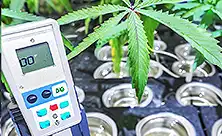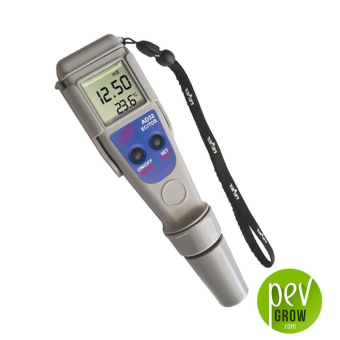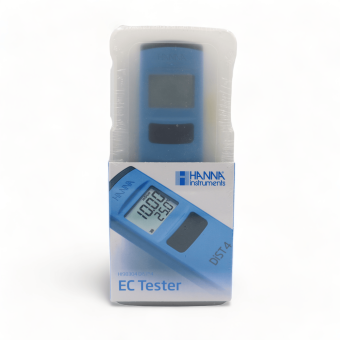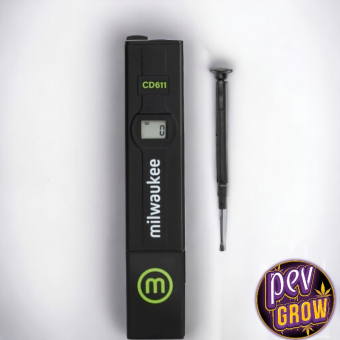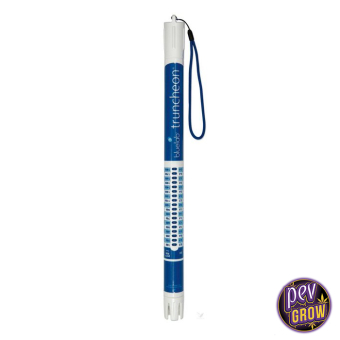

In constant struggle for the regulation of cannabis, mainly in the medicinal field.
14-07-2024 07:00:20 - Updated: 14 July, 2024
Thanks to the EC meters available on the market today, we can control the level of nutrients and salts that the irrigation water of our weed plant contains, thus protecting our crop from potential problems. Once again, we start by emphasizing the importance of daily learning techniques, tricks, and other paraphernalia related to the world of cannabis cultivation. What might seem like a simple task requires numerous skills that at Piensa en Verde we try to convey to you every day, in the clearest and simplest way possible.
In this regard, today we would like to talk about the importance of measuring and adjusting the electrical conductivity level of our weed cultivation, so we will start by explaining what it is, so we can understand its relevance, and then explain the different steps to take and the products needed to achieve it throughout the entire cultivation process. With this article, you will learn everything you need to know about EC in cannabis cultivation.
🔥 What is EC?
EC, or Electrical Conductivity, is a measure of a solution’s ability to conduct electricity. In cannabis cultivation, EC is used to determine the concentration of soluble salts (fertilizers for weed) in the irrigation water. This measurement is crucial because it indicates the amount of nutrients available to the plants.
📲 Why is Measuring EC Important?
Maintaining EC within the appropriate levels is vital to ensure that cannabis plants receive the correct amount of nutrients. An EC that is too high can cause nutrient toxicity, while an EC that is too low can lead to nutrient deficiencies. Both situations can negatively affect plant growth and yield.
Ideal EC Levels in Soil
Ideal EC levels vary depending on the plant’s growth stage and the type of growing medium used:
Germination and Seedling Stage
Ideal EC: 0.4 – 0.6 mS/cm
During this stage, young plants require very few nutrients. A low EC level ensures that young roots do not burn and can develop properly.
Vegetative Growth Stage
Ideal EC: 1.0 – 1.4 mS/cm
In this phase, plants are developing their structure, including leaves and branches. A moderate EC level provides enough nutrients for vigorous growth without causing toxicity.
Flowering Stage
Ideal EC: 1.4 – 2.0 mS/cm
During flowering, plants demand more nutrients to produce large, dense buds. Increasing the EC at this stage ensures that plants have access to the necessary nutrients for optimal flowering.
🚀 Factors Affecting EC
Type of Growing Medium
Soil: Soils have a natural buffering capacity, meaning they can tolerate EC fluctuations better than other media. However, it is important not to exceed the recommended EC to avoid salt buildup.
Coco: This inert medium requires more precise EC control as it lacks the buffering capacity of soil.
Hydroponics: In hydroponic and aeroponic systems, plants rely entirely on the nutrient solution. EC must be monitored and adjusted more frequently to ensure a proper nutrient balance.
Water Quality
Irrigation water should be of good quality, preferably with low EC (soft water). Using water with high EC can contribute to excess salts and unbalance plant nutrition.
🔥 Cannabis EC Value Table
| Week | Stage | Soil EC (mS/cm) | Coco EC (mS/cm) | Hydroponics EC (mS/cm) |
|---|---|---|---|---|
| 1 | Growth | 0.4 | 0.6 | 0.6 |
| 2 | Growth | 0.6 | 0.8 | 0.8 |
| 3 | Growth | 0.7 | 1.0 | 1.0 |
| 4 | Growth | 0.9 | 1.2 | 1.2 |
| 5 | Flowering | 1.0 | 1.2 | 1.4 |
| 6 | Flowering | 1.2 | 1.2 | 1.4 |
| 7 | Flowering | 1.4 | 1.3 | 1.5 |
| 8 | Flowering | 1.5 | 1.4 | 1.6 |
| 9 | Flowering | 1.6 | 1.6 | 1.8 |
| 10 | Flowering | 1.6 | 1.7 | 2.0 |
| 11 | Flowering | 1.7 | 1.9 | 2.0 |
| 12 | Flowering | 1.7 | 1.6 | 1.8 |
| 13 | Flowering | 1.8 | 1.6 | 1.8 |
| 14 | Flowering | 1.8 | 1.6 | 1.8 |
🎬 PPM Value Table for Cannabis
| Week | Stage | Soil PPM (ppm) | Coco PPM (ppm) | Hydroponics PPM (ppm) |
|---|---|---|---|---|
| 1 | Growth | 300 | 200 | 200 |
| 2 | Growth | 400 | 300 | 300 |
| 3 | Growth | 500 | 400 | 400 |
| 4 | Growth | 600 | 500 | 500 |
| 5 | Flowering | 700 | 600 | 700 |
| 6 | Flowering | 700 | 600 | 700 |
| 7 | Flowering | 750 | 650 | 750 |
| 8 | Flowering | 750 | 650 | 800 |
| 9 | Flowering | 800 | 700 | 850 |
| 10 | Flowering | 800 | 700 | 900 |
| 11 | Flowering | 850 | 750 | 950 |
| 12 | Flowering | 850 | 750 | 900 |
| 13 | Flowering | 900 | 800 | 900 |
| 14 | Flowering | 900 | 800 | 900 |
✅ Best EC Meters for Cannabis
Accurate EC measurement is essential to ensure that cannabis plants receive the right amount of nutrients at each stage of their growth. Below, we highlight some of the best EC meters available on the market, with budget options and a standout recommendation for its quality/price ratio.
Budget Models
Adwa AD32 Waterproof
This meter is an excellent budget option that offers accuracy and durability. Its waterproof design makes it ideal for growing environments where humidity is a constant factor.
Hanna HI 98304
Known for its ease of use and accuracy, the Hanna HI 98304 is a compact and portable meter that provides reliable results without breaking the bank. It is a popular choice among beginner and experienced growers.
CD 611ECO by Milwaukee
The CD 611ECO is an affordable and easy-to-use EC meter that provides quick and accurate readings. It is ideal for growers looking for an economical solution without sacrificing accuracy.
Best Value for Money
Bluelab Truncheon
The Bluelab Truncheon is widely recognized for its reliability and accuracy. Although it is more expensive than the budget models mentioned earlier, it offers exceptional durability and ease of use that justify its investment. Its robust design and button-free operation make it the preferred EC meter for many serious growers.
Each of these meters has its own advantages, and the choice of the best EC meter will depend on your specific needs and budget. By investing in a good EC meter, you can ensure that your weed plants receive the care and nutrients necessary for optimal growth and a bountiful harvest.
🧐 How to Measure and Adjust EC
Measurement Tools
EC Meter: This device measures the electrical conductivity of the nutrient solution. It is essential to calibrate the meter regularly to obtain accurate readings.
Adjusting EC
To increase EC, concentrated nutrients can be added to the solution. It is important to do this gradually and mix well before measuring again.
To reduce EC, the nutrient solution can be diluted with pure water (preferably low EC).
Practical Tips
Regular Monitoring: Regularly measuring the EC of the nutrient solution and the drainage water helps identify and correct nutritional problems in time.
Data Logging: Keeping a record of EC readings and plant growth observations can help adjust watering and nutrition practices more precisely.
Nutritional Balance: Ensure to provide balanced nutrition that includes all the necessary macronutrients and micronutrients for healthy weed growth.
👾 Conclusion
The EC meter is an essential tool in weed cultivation that helps ensure that plants receive the right amount of nutrients. By understanding and controlling EC, growers can maximize the yield and quality of their harvests. Whether you grow in soil, coco, or hydroponic systems, maintaining EC at optimal levels is key to successful weed cultivation.
⚠️ Pevgrow Opinion
In our opinion, generally, the importance of measuring and adjusting EC in weed cultivation is often overlooked. Many times, we think that more is better and add more nutrients than necessary, which can lead to excess or blockage that can decrease yield or quality of the harvest. Having a good EC meter is one of the best investments a grower can make, as it is a minimal expense compared to the reward we can obtain. If you have any questions, you can ask us in the comments or privately, but you must be clear about the importance of measuring electrical conductivity as well as pH, and in this regard, I recommend taking a look at this other article that explains what pH is and how to measure it in weed cultivation.
❤️ Frequently Asked Questions
How to increase EC in weed cultivation?
Measure Current EC:
Before making any adjustments, measure the EC of the nutrient solution and the drainage water. This will give you a reference of the current nutrient level.
Add Nutrients:
Select the Appropriate Fertilizer: Use fertilizers suitable for the growth stage of your plants (vegetative growth or flowering). Fertilizers should contain a balanced mix of macronutrients (nitrogen, phosphorus, potassium) and micronutrients.
Proper Dilution: Add the nutrients to the irrigation solution following the manufacturer’s instructions. It is better to add less than recommended and adjust gradually to avoid overfeeding.
Mix the Solution Well:
Ensure to mix the nutrient solution well after adding the nutrients. This guarantees an even distribution of nutrients and an accurate EC reading.
Measure EC After Adding Nutrients:
After mixing the nutrient solution, measure the EC again to check the increase. Compare this value with the desired level for your plants’ growth stage.
Gradual Adjustments:
If the EC still does not reach the desired level, add more nutrients gradually and repeat the mixing and measuring process. It is crucial not to make abrupt changes to avoid the risk of root burn and nutrient toxicity.
And how to lower EC?
Lowering EC is much easier; you just need to add water, and the total concentration of nutrients will decrease due to dilution in a larger amount of nutrient solution.

